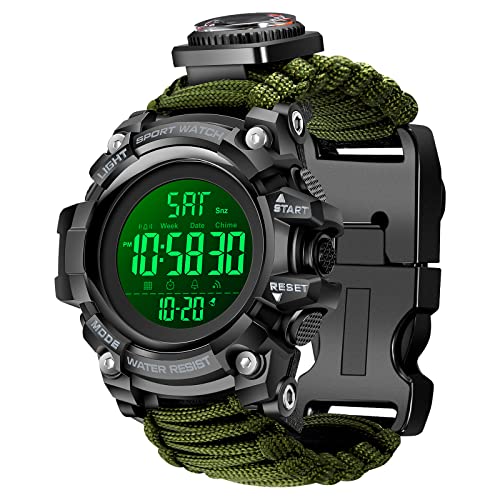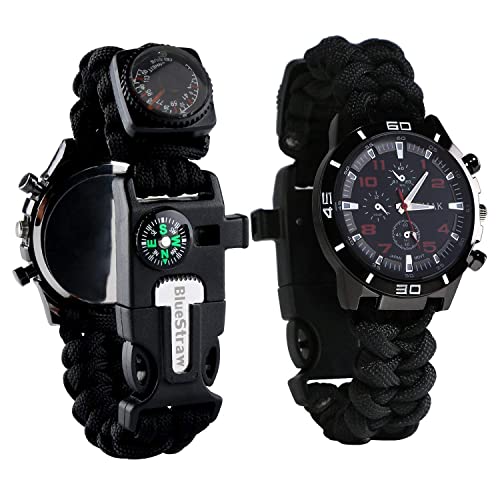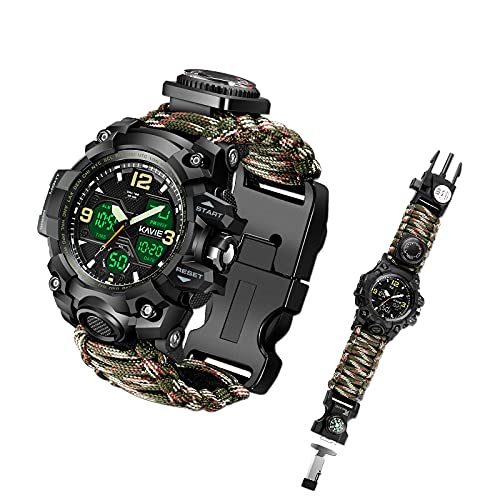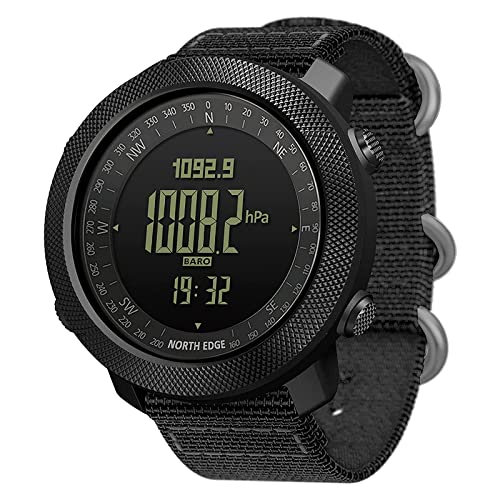Welcome to our blog! We understand the frustration of investing your hard-earned money in a product, only for it to break or fail shortly after purchase. That’s why we want to dive into the importance of durability and resistance in products, and help you make informed decisions. In this post, we will explore the concept of durability, discuss the factors that contribute to a product’s resistance, and provide valuable tips on choosing long-lasting items. So, join us as we uncover the secrets to finding durable and resistant products that will withstand the test of time.
Top Picks for Reliable Survival Watches
Understanding Durability
Durability is a crucial aspect to consider when purchasing any product. Whether it’s a smartphone, a piece of furniture, or a pair of shoes, understanding the durability of a product can save you money and ensure that your investment lasts for a long time. In this blog section, we will delve into the concept of durability, exploring its significance in product selection and uncovering the factors that contribute to it.
The Factors that Contribute to Durability
1. Quality of Materials Used
The choice of materials plays a vital role in determining a product’s durability. High-quality materials are more likely to withstand wear and tear, environmental factors, and frequent use. Conversely, low-quality materials may quickly deteriorate, resulting in a shorter lifespan for the product. Some of the key contributing materials to durability include:
- Strong and durable metals, such as stainless steel or aluminum
- High-quality leathers for bags, shoes, or furniture
- Robust fabrics resistant to tearing or fading
- Reinforced plastics or composites for electronics or appliances
2. Manufacturing Processes
The manufacturing processes employed by a company can greatly impact the durability of their products. Meticulous attention to detail, precision engineering, and rigorous quality control protocols ensure that products are built to last. Factors to consider in manufacturing processes include:
- Stringent quality checks during production to detect and eliminate flaws or defects
- Use of advanced technologies and machinery for precise assembly and construction
- Adherence to industry standards and best practices
- Implementation of robust testing procedures to simulate real-life usage scenarios
3. Design Considerations
Intelligent design can significantly enhance the durability of a product. A well-designed product takes into account the potential stress points, weak areas, and anticipated usage patterns. By addressing these considerations, the designers can better align the form and function of a product to optimize its durability. Key design considerations include:
- Reinforcement of high-stress areas with additional support or materials
- Ergonomic designs that reduce strain during use, preventing premature wear or damage
- Modular designs that allow for easy repair or replacement of individual components
- Protective features such as water resistance, shock resistance, or impact absorption
The Benefits of Choosing Durability
Opting for durable products provides numerous benefits that make it a wise investment in the long run. Consider the following advantages:
- Cost-effectiveness: Durable products may initially have a higher price tag, but they save you money in the long term by reducing the need for frequent replacements or repairs.
- Reduced environmental impact: By opting for durable items, we decrease the demand for new production, reducing waste and conserving natural resources.
- Enhanced user experience: Durable products provide consistent performance, reliability, and longevity, ensuring a satisfying and enjoyable user experience.
- Product integrity: Durability is often an indicator of overall quality, ensuring that the product maintains its functionality, aesthetics, and value over time.
Remember, when selecting a product, don’t solely focus on initial cost or aesthetics. Take durability into account to make a more informed decision that ensures you get the most out of your investment.
So, whether you’re buying a new gadget or furnishing your home, make durability a top priority. It’s not just about saving money—it’s about choosing products that stand the test of time and offer a more sustainable and satisfying ownership experience.
Importance of Resistance
When it comes to the durability and longevity of products, the concept of resistance plays a crucial role. From electronics to outdoor gear and household items, resistance is a vital feature that ensures these products can withstand external forces and adverse conditions. In this blog, we will explore the significance of resistance in various contexts and shed light on its different types.
Types of Resistance
1. Water Resistance
Water resistance is a property that prevents the ingress of water into a product, protecting it from damage. Whether it’s a smartphone, watch, or even a backpack, having water resistance adds a layer of protection against accidental spills, rain, or even submersion to a certain depth. Key benefits of water resistance include:
- Extend product lifespan by minimizing water-related damage.
- Allows usage in wet and humid environments without fear of malfunction.
- Enables worry-free outdoor activities like swimming or hiking in the rain.
2. Impact Resistance
Impact resistance refers to a product’s ability to withstand physical shocks and bumps. When it comes to electronics and outdoor gear, having impact resistance ensures that accidental drops and rough handling won’t lead to immediate breakdown or damage. Here are some reasons why impact resistance is important:
- Provides peace of mind knowing that the product can withstand accidental drops or impacts.
- Reduces the need for repairs or replacement, saving both time and money.
- Suitable for outdoor enthusiasts or those working in physically demanding environments.
3. Corrosion Resistance
In the realm of household items, corrosion resistance becomes particularly essential. It prevents materials like metals and alloys from deterioration due to exposure to moisture, chemicals, or other corrosive elements. The advantages of corrosion resistance are numerous:
- Increases the lifespan of household items, maintaining their functionality over time.
- Saves money by reducing the need for frequent replacement.
- Prevents potential health hazards that may arise from corroded materials.
The Benefits of Resistance
Having a product that incorporates resistance features has several distinct advantages. Let’s take a closer look at why resistance is such a crucial aspect in various applications:
- Product Longevity: Resistance properties contribute significantly to the lifespan of products by protecting them from potentially damaging factors, allowing users to enjoy them for a longer period.
- Cost-Effectiveness: Resistance ensures a reduction in repair and replacement costs, ultimately saving consumers money in the long run.
- Peace of Mind: With resistant products, users can have peace of mind, knowing that their belongings are properly safeguarded against everyday wear and tear, accidental mishaps, and harsh environmental conditions.
- Versatility: Resistance features broaden the scope of product usage, making them suitable for a wider range of applications and environments.
For a clearer comparison, refer to the table below, summarizing the key points regarding the importance and benefits of resistance:
| Type of Resistance | Importance | Benefits |
|---|---|---|
| Water Resistance | Protects against water-related damage | Extends product lifespan |
| Enables usage in wet and humid environments | Allows outdoor activities without concerns | |
| Impact Resistance | Prevents damage from accidental drops | Saves repair and replacement costs |
| Suitable for physically demanding use | Provides peace of mind | |
| Corrosion Resistance | Prevents material deterioration | Increases lifespan of household items |
| Reduces health hazards | Saves money by minimizing replacement needs |
In conclusion, resistance features in products greatly contribute to their durability, functionality, and value for customers. Whether it’s water resistance, impact resistance, or corrosion resistance, incorporating these properties extends the lifespan, saves costs, and ensures peace of mind for users. So, when purchasing your next product, be sure to consider the importance of resistance to make a wise and long-lasting investment.
Choosing the Right Products
When it comes to purchasing products, we all want value for our money. Choosing durable and resistant products ensures that we make an investment that lasts longer and performs better in the long run. In this blog section, we will provide practical tips and guidelines for selecting products that will stand the test of time. From considering the intended use and environmental conditions to researching brands and manufacturers, here’s everything you need to know to make an informed decision.
Factors to Consider
Intended Use
One of the first factors to consider when deciding on a product is its intended use. You need to assess how frequently you will use the product and the demands you will place on it. Different products will be subjected to varying levels of stress and wear depending on their purpose. Understanding the product’s intended use will help you determine the level of durability and resistance required.
Environmental Conditions
The environment in which the product will be used is another essential factor to consider. Think about the expected conditions that the product will be exposed to. Will it be used indoors or outdoors? Will it be exposed to extreme temperatures, moisture, or other harsh conditions? Considering the environmental factors will help you choose a product that can withstand and perform well in those conditions.
Brand and Manufacturer Reputation
Researching the reputation of the brand or manufacturer is a crucial step in selecting a durable and resistant product. Look for brands that have a history of producing high-quality and reliable products. Reading customer reviews, checking for certifications, and considering the brand’s track record will give you insights into the reliability and performance of the product you are interested in.
Key Product Categories
Now that we have discussed the factors to consider, let’s dive into specific product categories where durability and resistance are crucial.
Watches
Watches are an essential accessory that we wear daily and rely on for accurate timekeeping. When choosing a watch, consider the following:
- Material quality: Opt for watches made of durable materials such as stainless steel or sapphire crystal for the case and strap.
- Water resistance: Ensure that the watch has an appropriate level of water resistance for your needs, especially if you plan to wear it during water-related activities.
- Movement type: Choose watches with reliable movements such as automatic or quartz movements for better durability and accuracy.
- reputable brand: Trusted watch manufacturers often incorporate high-quality components and craftsmanship in their products, ensuring longevity and reliability.
Smartphones
Smartphones have become an integral part of our daily lives, and their durability is paramount. Consider the following when choosing a smartphone:
- Build quality: Opt for smartphones with a sturdy build, using materials like Gorilla Glass for the display and durable metal or glass for the frame.
- Water and dust resistance: Look for smartphones that offer water and dust resistance ratings, especially if you anticipate exposing your device to such conditions.
- Battery life: Assess the battery life of a smartphone, as longer-lasting batteries contribute to the overall durability and usability of the device.
- Software updates: Choose smartphones from brands that provide regular software updates to ensure optimal performance and security over time.
Outdoor Equipment
Outdoor equipment, such as camping gear or hiking gear, needs to withstand rugged conditions. Here are key considerations for choosing durable outdoor equipment:
- Material durability: Opt for equipment made from robust materials, like sturdy nylon or aluminum, that can withstand rough handling and exposure to the elements.
- Weather resistance: Look for equipment that is weather resistant, meaning it can maintain its performance and integrity even in adverse weather conditions.
- Reinforced stitching and construction: Check for reinforced stitching and durable construction techniques that ensure the equipment can withstand heavy use and strain.
- Warranty and customer support: Choose brands that offer reliable warranties and excellent customer support to address any issues that may arise with your outdoor equipment.
Maintaining Durability and Resistance
When investing in durable and resistant products, whether it’s outdoor furniture, electronics, or clothing, it’s important to take proper care to ensure their longevity. In this blog section, we will share expert tips and tricks to help you maintain the durability and resistance of your favorite products for years to come.
Cleaning Methods
Keeping your products clean not only enhances their visual appeal but also helps maintain their durability and resistance. Here are some recommended cleaning methods to consider:
- Gentle Hand Washing: For delicate items, such as clothing or electronics, hand-washing using a mild detergent and lukewarm water is often the safest method.
- Spot Cleaning: For quick touch-ups, spot cleaning with a suitable cleaner and a soft cloth can effectively remove stains without compromising the product’s durability.
- Machine Washing: Some products, like outdoor cushions or clothing made from durable fabrics, may be suitable for machine washing. However, always check the care instructions to ensure you’re using the proper settings.
- Pressure Washing: For outdoor furniture or resistant surfaces, pressure washing can effortlessly remove dirt and grime. Be sure to adjust the pressure according to the material’s tolerance.
Storage Practices
Proper storage is crucial to protecting your durable and resistant products during periods of non-use or when they’re not exposed to the elements. Consider implementing these storage practices:
- Clean and Dry: Before storing any product, make sure it’s thoroughly cleaned and dried to prevent the growth of mold or mildew.
- Climate-Controlled Storage: If possible, store your items in a climate-controlled environment to avoid exposure to extreme temperatures, which can weaken materials over time.
- Covering and Protection: Use appropriate covers or protective cases to shield your products from dust, moisture, and potential damage during storage.
- Proper Hanging and Folding: When storing clothing or fabrics, hang them on appropriate hangers or fold them neatly to minimize creasing and stretching.
Regular Maintenance Routines
Implementing regular maintenance routines can significantly extend the durability and resistance of your products. Here are some recommended maintenance practices:
- Inspect and Repair: Regularly inspect your products for any signs of damage or wear. Promptly address any issues to prevent further deterioration.
- Reapply Protective Coatings: For items like outdoor furniture or footwear, periodically reapply protective coatings, such as water repellents or UV inhibitors, according to the manufacturer’s recommendations.
- Tighten and Lubricate: Check and tighten any loose screws, bolts, or hinges that may impact the durability of your products. Lubricate moving parts if necessary.
- Rotate and Mix Up Usage: To evenly distribute wear and tear, consider rotating the use of your products. Use different items from your wardrobe, alternate seating options, or change the position of electronic devices regularly.
Assessing the Longevity and Robustness of Products
In conclusion, durability and resistance play a crucial role in ensuring the longevity and quality of products. By prioritizing these factors and making informed purchasing decisions, consumers can not only save money in the long run but also contribute to reducing waste and environmental impact. Remember to choose products that meet your specific needs and take proper care to maintain their durability and resistance. Ultimately, investing in products that are built to last will bring you greater satisfaction and value.
















